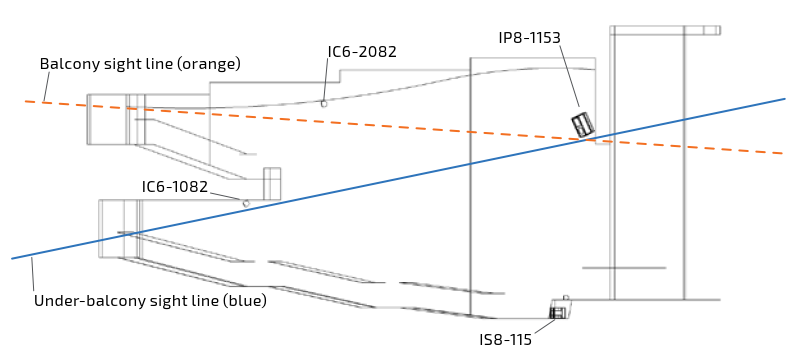Multi-Level Venues
There are many sizes, styles and types of performance and presentation spaces. This system design template describes loudspeaker design considerations for rooms with balconies or multiple levels in typical educational, meeting room and performance applications. The concepts covered are intended to be used as a primer for the presentation and performance design guides available for these venue types.
General coverage guidelines
- To preserve sight lines, the main loudspeakers usually must be kept above the "blue" sight line shown for the first floor rear seat listeners (or any positions where the loudspeakers might obstruct the view of the stage).
- The under-balcony IC6-1082 fill loudspeakers should be located slightly down-stage of the "blue" sight line to the main PA loudspeakers.
- Similarly, the over-balcony IC6-2082 supplemental loudspeakers should be positioned above the "dashed orange" sight line to the stage.
- For large balcony areas, instead of the IC6-2082s shown here, consider larger-format IP6/8-1122 two-ways.
- For both the under- and over-balcony listening areas, adjust the signal delays to preserve the illusion that the sound provided by the balcony coverage loudspeakers is actually coming from the stage.
- When the main loudspeaker array must trim high relative to the front seating, localization levels in front may be poor (light green shaded area). "Localization" refers to the direction that sound appears to be coming from - either overhead or on-stage. To rectify this, consider placing IC6-1062 fills along the stage lip to support the front seating (light blue shaded area). Coverage of the under- and over-balcony fills is shown in light orange.
What is the effective projection distance for a point source loudspeaker? Use the 3:1 Rule for D2 (Distance to furthest listener) and D1 (Distance to closest listener) to approximate the area over which the loudspeaker provides +/-3dB variation in SPL: D2 ≤ D1 x 3.
Subwoofers
For purpose-built venues of this type, subwoofers can often be integrated into, or perhaps concealed within, the stage front. Where possible, array the subwoofers evenly across the front of the stage to avoid the “power alley” effect caused by positioning them at the extreme right & left of the proscenium. Overhead subwoofer suspension may warrant cardioid or forward-steered arrays to raise bass levels in the seating while preserving GBF (Gain Before Feedback) on the stage.




